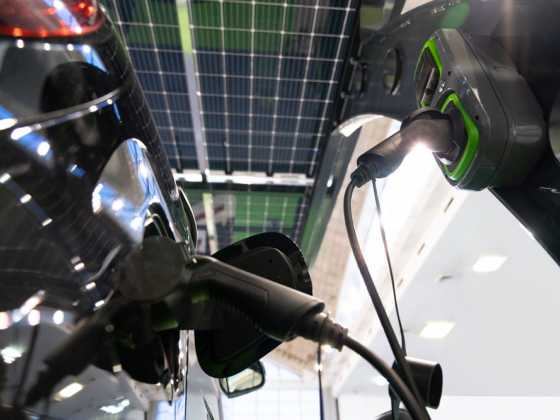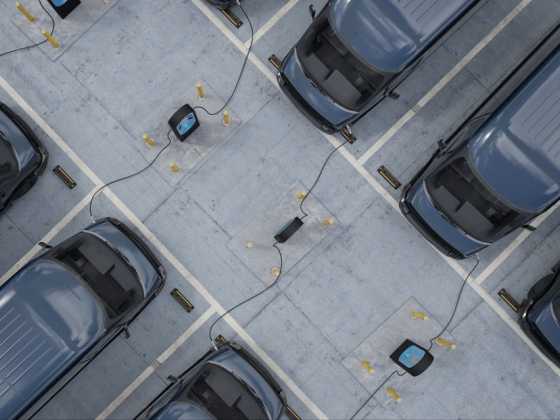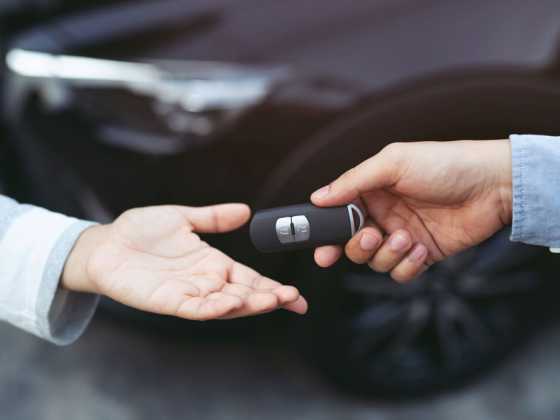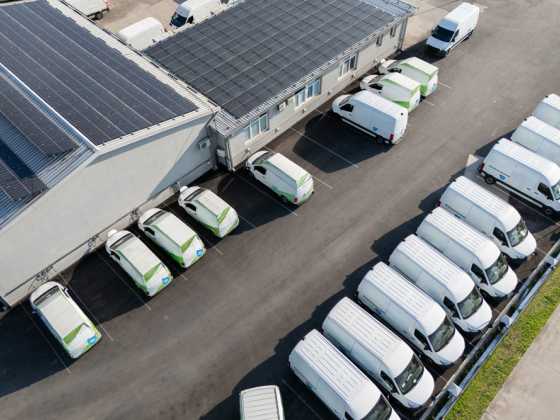2017 Frankfurt motor show round-up
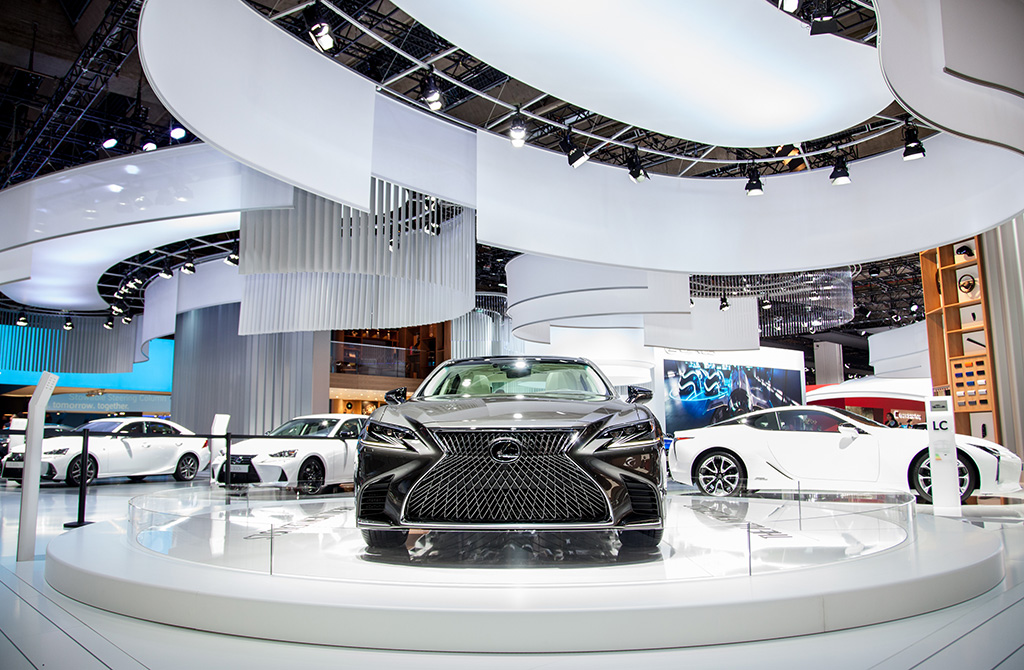
Electro-mobility was one of the key themes at the 2017 Frankfurt motor show which ran from 14-24 September. GreenFleet takes a tour of the vast halls at Frankfurt/Main and reports on the concepts and cars which embodied the IAA 2017’s ‘future now’ billing
ELECTRIC VEHICLES
Audi Aicon and Elaine
German carmaker Audi pulled the covers off its four-door autonomous vision of the future at the 67th running of the Frankfurt motor show. The luxurious 2+2 concept featured no steering wheel or pedals, but of more relevance to driving now, was the all-electric Aicon’s ability to cover between 435-497 miles (700-800km) on a single charge. Four electric motors power the front and rear axles, while solid body batteries are stored under the car’s floor, and offer more energy capacity than traditional lithium-ion units.
Total system power of the Aicon is 260kW, with 405.7lb ft (500Nm) of torque available through the quattro all-wheel drive system. Powertrain and electric brake units recover energy, while lightweight construction and optimised aerodynamics also help efficiency. A high-voltage 800-volt system ensures the battery unit can be recharged to 80 per cent of its capacity in less than 30 minutes, while the autonomous Audi also featured inductive, wireless, charging.

Alongside the Aicon, Audi also showcased the Elaine, an electrically-powered SUV coupé. It also offered autonomous technology and ‘Audi AI’ (artificial intelligence), and like the Aicon, the Elaine was said to be able to drive automatically to a charging post. The Audi Elaine featured Level 4 autonomy – the US-based SAE system is currently topped at Level 5 – as well as 320kW of power, while a 95kWh battery was said to boast a range in excess of 310 miles (500km). The option of a 150kW wired fast-charging system or wireless charging via the Audi Wireless Charging System were ways of refilling the car’s batteries.
BMW i3S
Now an established electric vehicle benchmark, a new and sportier version of the BMW i3 was unveiled in Frankfurt. The BMW i3S features 10mm lowered suspension and a 40mm widened track for more improved and dynamic roadholding, while the 20-inch alloy wheels are 20mm wider than those so far available on BMW’s premium compact EV best-seller.

The higher performance i3 is powered by a 135kW/184bhp electric motor with 199lb ft/270Nm of torque (up 10kW/14bhp and 15lb ft/20Nm) while a modified motor control delivers up to 40 per cent more speed range, power and torque than the standard car. The i3S gets from 0-62mph in 6.9 seconds, while top speed is 99mph.
With an official range of 174 miles (280km) on the NEDC cycle, new body styling flourishes help to mark out the most powerful i3. The standard car also gets a mild refresh, too, while both cars receive LED headlamps as standard and run the same 94Ah/33kWh lithium-ion batteries as before. A range extender engine is also still available on both versions.
BMW i Vision Dynamics
The big news on BMW’s IAA 2017 stand was the unveiling of the i Vision Dynamics electric concept car. A four-door ‘Gran Coupé’, the i Vision Dynamics has an official range of 373 miles (600km) and a top speed of 120mph (200km/h). BMW stated that it accelerates from 0 to 62mph in four seconds and “offers a look ahead to the e-mobility experience of the future”.

The style of the i Vision Dynamics hinted at what a car which sits in-between the current i3 and i8 could look like. With flush surfaces for aerodynamic efficiency and barely visible joins, the i Vision Dynamics has a long wheelbase with short overhangs. In a departure for the brand, the trademark ‘kidney’ grille is turned into an ‘intelligent surface’ which houses myriad sensors. In line with other big-hitting car makers’ announcements at the German expo, BMW will have 25 models with electrified drive systems on sale by 2025, of which 12 will be pure-electric.
GKN eDrive system
Automotive driveline technology company GKN pulled the wraps off a new electric axle concept in Hall 5 at Frankfurt. The ‘eTwinsterX’ eAxle’s integrated coaxial format features a smaller electric drive unit than other systems with the same power output. It can also be adapted to suit most vehicles from city cars to luxury plug-in hybrid SUVs, with any drive system: front, rear, or all-wheel drive.

The ‘eTwinsterX’ system also has a two-speed transmission which optimises gear changes for ultimate efficiency, while torque vectoring technology delivers, according to GKN, ‘significant advantages for vehicle stability, agility and safety’. GKN’s new system can also be used as the primary drive in fully-electric vehicles, or as the secondary drive on plug-in hybrid vehicles: the company has already supplied eAxles for the BMW i8 and 2 Series Active Tourer, Porsche 918 Spyder, and Volvo XC90 T8 Twin Engine PHEVs.
Honda Urban EV Concept
It was global motor show debut for Honda’s cute pure-electric concept car. Built on an entirely new platform, the Japanese company stated that the Urban EV Concept points to design and technology which will feature on a future battery electric Honda. The car will spawn a production version, too, with Honda Motor Co President and CEO, Takahiro Hachigo commenting, “This is not some vision of the distant future; a production version of this car will be here in Europe in 2019”.
Shorter than a Jazz supermini, the Urban EV Concept’s styling is unashamedly retro, yet also modern, thanks to backlit logos, as well as interactive messages or charging updates which can be displayed between the headlights. Inside, two bench seats accommodate four passengers, while contemporary wood finishes contrast with the ‘floating’ dashboard console and panoramic screen which wraps around the front of the cabin and extends into the doors. The car’s electric charging cable connection is housed on the bonnet. No details were given on the car’s range or power output.

Honda also unveiled its Honda Power Manager system, which can store energy more efficiently, releasing renewable-generated electricity back into the home or the grid. This follows on from Honda’s ‘Electric Vision’ strategy, which was launched at the 2017 Geneva motor show and includes the development of a dedicated EV platform with a fully-electric powertrain.
High-density battery packs and integrated heat management energy transfer functions are expected to feature, and two-thirds of the Japanese company’s range is expected to be electrified by 2030. A production version of the CR-V Hybrid Prototype also displayed at Frankfurt will arrive in 2018, and will be Honda’s first electrified SUV in Europe.
Jaguar I-Pace electric racing series
Jaguar’s first full-electric car has been seen at motor shows across the world over the past year, but this year’s German motor show saw the announcement of the world’s first international championship for production-based electric cars. The Jaguar Racing I-Pace eTrophy will support the FIA Formula E series, and will take place at the same venues and on the same dates, starting in late 2018.

The series will also support the roll-out of the production version of the I-Pace road car, as well as showcasing future racing talent in a zero-emissions racing championship. Up to 20 cars will form the grids in global cities such as Hong Kong, Paris and New York, and the racers will be built by Jaguar Land Rover Special Vehicle Operations (SVO) in Warwickshire.
Mercedes-Benz Concept EQA
Following on from last year’s Generation EQ crossover shown at the Paris motor show, Mercedes-Benz pulled the wraps from its family hatchback electric vehicle concept, the EQA. Playing on its A-Class size association, the Concept EQA is the company’s first all-electric EQ concept car in the compact market. Powered by a pair of electric motors – one each on the front and rear axles – with a system output which can exceed 200kW, the official quoted range of the Concept EQA is around 250 miles (400km) depending on capacity.
Mercedes-Benz states that the Concept EQA’s permanent all-wheel drive delivers “impressive dynamic performance”, thanks to architecture exclusively designed for battery-electric models. A pair of drive programmes offer a choice of individual tailored drive settings, while the electric Mercedes can be charged by a wallbox, rapid charge points, or even inductively. The company’s ‘Mercedes-me’ service allows for easy refilling and payment at a range of different charging stations.

Among the Concept EQA’s other technological developments was laser fibre lighting, which uses fibre-optic cables: the front ‘grille’ can change its appearance depending on which drive programme is selected. The ‘EQ’ name stands for ‘Electric Intelligence’, and the German company’s electric ambitions state that it will have launched 10 pure EV models by 2022, the first of which will be the EQC, the production version of the 2016 Generation EQ crossover. This will start leaving Mercedes-Benz’s Bremen factory in 2019.
Mercedes-Benz GLC F-Cell
Not your usual zero-emissions battery electric vehicle, German carmaker Mercedes-Benz launched the world’s first EV with a fuel-cell/battery powertrain at the Frankfurt event. Sweeping the technology under the ‘EQ Power’ brand, the plug-in hybrid Mercedes is said to have an official range of up to 272 miles (437km) with 4.4kg of hydrogen on-board. Electric range is up to 30 miles (49km), while power output is 147kW (200bhp). Mercedes billed the car as a fuel-cell vehicle which uses a 13.8kWh lithium-ion battery as an additional energy source. This can be charged by plug-in technology in around 1.5 hours thanks to an on-board 7.2kW charger.

Four operating modes ensure the GLC F-Cell runs at optimum efficiency. ‘Hybrid’ mode sees the car draw power from both energy sources, with the battery handling the power peaks, the fuel-cell running when efficiency is needed. In ‘F-Cell’ mode, the battery’s charge is kept constant by the energy from the fuel-cell. The GLC F-Cell uses ‘Battery’ mode and the all-electric powertrain for short distances, while in ‘Charge’ mode, the battery is charged as a priority, ideal for when the hydrogen tanks need refuelling. An energy recovery system puts braking or coasting energy back in the battery when decelerating.
Mini Electric Concept
Almost a decade after the first all-electric Mini E was field-trialled to selected members of the public came the unveiling of the Mini Electric Concept. Celebrating its world premiere in Frankfurt, the all-electric concept car heralded a production version which will be go on sale from 2019. “With its characteristic go-kart feel and powerful electric motor, the Mini Electric Concept is great fun to drive while also being suitable for everyday use – and producing zero emissions to boot,” said Peter Schwarzenbauer, member of the board of management of BMW AG, responsible for MINI, Rolls-Royce and BMW Motorrad.

The yellow and silver colour scheme is just one cue which the 2017 electric Mini concept references back to its 2008 sibling, as well as the distinctive ‘E’ badge. The standard Mini’s four-square and minimalist overhangs remain, while fibreglass side skirts add more visual appeal. Striking rear LED tail lamps feature half a Union Jack flag on each side, playing to the car’s UK manufacturing base and heritage. No details on drivetrain options were given in Germany, and the production car will follow the introduction of the Mini Countryman Plug-in Hybrid which was introduced earlier this year.
Renault Symbioz
Renault’s Symbioz concept actually came in two forms at the German show, a 2030 forward-looking car, and a 2023 ‘demo’ version, which will be nearer to a production model. Designed for fully-autonomous driving, Renault states that when on the road, the Symbioz is an “extension of the home”, while when parked inside the home, it “doubles as an extra multi-purpose room”. The French carmaker’s Symbioz system also shares power between the car and the home via a smart grid, while an artificial intelligence system anticipates the occupants’ needs.

Of more importance is the Symbioz demo car’s electric vehicle platform. A pair of electric motors are mounted on the rear axle, each motor driving one wheel. Power is 500kW with 442lb ft (600Nm) of torque providing 0-62mph acceleration in less than six seconds, while range is quoted as 310 miles (500km). According to Renault, recharging the car’s 72kWh batteries to 80 per cent of their capacity takes just 20 minutes, or they can be refilled by an inductive charging system.
Smart Vision EQ Fortwo
Like the Mercedes-Benz Concept EQA, Smart also premiered its own electric concept car which showcased “a new vision of urban mobility and individualised, highly flexible public transport”. The autonomous car – there is no steering wheel or pedals – collects passengers from their chosen location, while an array of individualisation options on the front, side, and rear panels help users identify which Smart Vision EQ Fortwo is ‘their’ car.

Even bigger news for Smart at Frankfurt, though, was the announcement that it will become the world’s first car maker to move from an all-combustion engine line-up to a full all-electric range of cars. “We are planning to move our Smart brand entirely to electric drive in Europe and North America by the end of the decade,” said Dr Dieter Zetsche. “The rest of the world will follow shortly after.” Bold claims indeed.
Volkswagen I.D. Crozz
Global number one car maker Volkswagen ploughed on with its new electric car offensive in Frankfurt with the reveal of an updated I.D. Crozz concept, the first version of which was unveiled at the 2017 Shanghai motor show in China. Displayed alongside the previously-shown all-electric I.D. hatchback and I.D. Buzz show cars, the latest I.D. Crozz again took the form of an SUV-influenced coupé.
The production version of the metallic red show car will be the second all-electric vehicle to appear after the 2020 introduction of the I.D., both of which will be followed by the 2022 pure-electric updating of the company’s iconic T2 campervan, the I.D. Buzz. And, by 2025, there will be a range of 23 all-electric Volkswagens, thanks to a five-year, €6 billion investment into e-mobility following the 2015 ‘Dieselgate’ diesel emissions issue.
The I.D. Crozz marries an electric 4Motion all-wheel drive system to a twin-electric motor powertrain, controlled by an ‘electric propshaft’ which distributes the power from the front and rear axle-mounted motors. System output is 225kW, while Volkswagen quotes an official range of 500km (310 miles) on one battery charge. The battery can be rapid-charged to 80 per cent capacity in 30 minutes, while the I.D. Crozz will glide onto a top speed of 112mph.

Other technological developments include an ‘Open Space’ interior, which, Volkswagen states, features a “superior amount of space and a highly versatile seating concept”, and the omission of traditional B-pillars. There is also a newly-developed CleanAir system which always maintains a supply of clean air into the cabin regardless of outside ambient conditions.
As well as the I.D. Crozz, the Volkswagen Group as a whole announced a comprehensive electrification initiative which will see 80 new electric vehicles launched by 2025. ‘Roadmap E’ will see over €20 billion earmarked for e-mobility, while the group’s battery strategy will be driven forward, with an order volume of over €50 billion put out to tender.
In basic terms, that means that by 2030 each Volkswagen Group model range will have at least one electrified version across all brands and all markets. Away from e-mobility, the group also announced every diesel engine will now feature an SCR (selective catalytic reduction) catalytic converter, while every petrol engine will gain a particulate filter. The expansion of natural gas and CNG-powered vehicles was also promised, with versions of the new SEAT Ibiza and Volkswagen Polo already featuring new 1.0-litre ‘TGI’ gas-powered drivetrains.
PLUG-IN HYBRIDS
London EV Company TX
Appearing in the ‘New Mobility World’ section at the IAA 2017, the recently-unveiled London EV Company electric TX taxi debuted with new German taxi livery in Frankfurt, and highlighted the car’s readiness for German and other markets.

The zero-emissions capable car displayed its eCity technology for the first time, its battery-electric powertrain and small petrol generator capable of almost 400 miles (over 640km) of range, with all-electric range being around 75 miles (120km), the equivalent of London to Edinburgh or London to Paris without the need to stop for fuel.
CONVENTIONALLY-FUELLED CARS
Honeywell turbocharger technology
Global automotive technology developer Honeywell unveiled its newest petrol turbocharger technology in Frankfurt, which debuted on the new range of 2.0-litre engines from BMW. The third generation of the company’s petrol turbocharger technology, the latest system offers more power and torque than before, with a new wastegate and mono-block arm and valve which offers reduced noise and better economy (up 0.5 per cent) than before.
Fifty per cent less wear is also promised, while electric actuation of the valve itself also reduces the time needed to engage the catalytic converter for managing the engine emissions associated with cold starts. Honeywell also displayed its new two-stage wastegate-VNT diesel turbocharger, currently installed in the Vauxhall Astra 1.6-litre engine. Electric actuation and a more compact side-by-side design helps reduce NOx by up to 20 per cent and CO2 emissions by 10 per cent.


